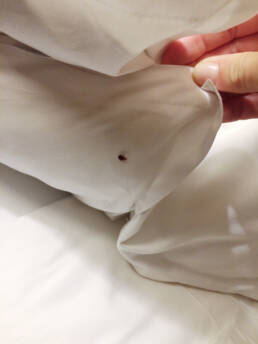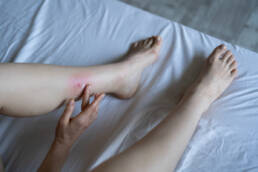Unwanted Guests: Understanding the Bed Bug Invasion
Bed Bugs, the tiny, blood-feeding pests that have plagued humans for centuries, have been making an unwelcome resurgence in recent years. If you’ve found yourself facing these pesky intruders, you’re not alone. Understanding how you got bed bugs in the first place is the crucial first step in preventing future infestations.
The Mystery of Bed Bug Arrival
Bed Bugs are experts at hitchhiking their way into our lives. They don’t discriminate between clean or dirty environments, and they can infest even the most upscale hotels or pristine homes. Here are some common ways bed bugs make their entrance:
Used Furniture
Used furniture is the top way to get bed bugs. If you don’t know where it came from, it is not wise to bring it home. Chances are that the used furniture you see at a garbage dumpster is infested with bed bugs! It doesn’t matter if it is a bed frame, a mattress, a box spring, a dresser, a nightstand, or a couch, if bed bugs are present; they are coming home with you.
How to prevent bed bug infestations from used furniture
Bed bugs can survive up to a year without a blood meal, so don’t make the mistake of trying to wait them out.
Used Clothes
People discard clothes that are infested with bed bugs all the time. If you, or someone you know collects discarding clothes, then chances are that some of your “treasures” will have bed bugs
When you buy used clothes, keep them in a sealed plastic bag until you can wash and dry them. Bed Bug eggs have been known to survive a good washing, but it is a fact that they cannot survive the heat of a modern dryer.
How to prevent bed bug infestations from used clothes
Drying bed bug-infested clothes for at least 25 minutes on high heat in the dryer will kill bed bugs and their eggs.
Traveling
When you stay in a hotel, or motel, bed bugs can infest your luggage, your clothes and can even come home with you if you are not careful. The best way to prevent being a carrier of Hot Bugz lectularius (bed bugs) and avoid an infestation is to inspect the bed and room before you sleep in it. You should also place your luggage on a chrome luggage rack. If you have a hanging bag, keep it hung up and zipped up too. Don’t ever put your clothes in the wood dressers or leave your items on the floor.
How to prevent bed bug infestations from traveling
- It is always a good idea to inspect the hotel bed before you sleep in it. When you return home, wash and dry all your clothes.
- The Bed bug registry is a great tool to find out if the place you’re staying at has prior reported bed bug outbreaks. Check to see if there are reports by entering the hotel or motel address, you’re staying at.
It’s not 100% accurate because anyone can make an entry and it doesn’t always have the most accurate information for a specific location but it can be a good indicator.
House Guests
If a friend or family member comes to stay with you, they could be bringing bed bugs with them and into your home. It’s hard to approach your loved ones to discuss the subject of bed bugs but once you experience the hassle and cost of cleaning up a bed bug infestation, it will get easier to have the conversation first!
How to prevent bed bug infestations from house guests
Bed bugs don’t discriminate. They don’t care how clean you are, how dirty you are, or how much money you make. Bed Bugs just want your blood so be aware.
Next-Door Neighbors
If you live in a multiunit apartment or house, bed bugs can infest your rooms by traveling on clothes, backpacks, purses, or wiring behind the walls. Apartments with hallways are not ideal. Bed bugs can crawl under the door and across or down the hall to your door. Infested furniture being brought out might drop off some bed bugs in the hall and come to your door.
How to prevent bed bug infestations from neighbors
You cannot pick your neighbors, so short of moving, keep a watch on your complex’s garbage dumpster to see if any of your neighbors are throwing away mattresses, couches, chairs or other large items that they could probably sell, as a sign that they might have an infestation.
How Can I Prevent Bed Bug Infestations?
Once you’ve dealt with a bed bug infestation, the last thing you want is a repeat performance. To keep these unwelcome guests at bay, consider these preventive measures:
- Inspect Regularly: Routinely check your home for signs of bed bugs, including reddish-brown bugs, small white eggs, and tiny dark fecal spots. Early detection is key to preventing a full-blown infestation.
- Keep Clutter to a Minimum: Bed bugs thrive in cluttered spaces where they can hide. Declutter your living areas to eliminate their hiding spots.
- Seal Entry Points: Make it difficult for bed bugs to enter by sealing cracks and crevices in walls, floors, and furniture.
- Use Protective Covers: Invest in bed bug-proof encasements for your mattress and box spring to trap any potential invaders.
- Educate Yourself: Learn about bed bug prevention techniques and stay informed about the latest bed bug trends in your area.
Bed bugs are getting resistant to pesticides. We have to use things they can’t resist.
“Our results so far, have indicated that two of the products commonly used for bed bug control only killed 50% of them after 10 days of constant exposure. We have also found that products thought to be repellent to bed bugs were not repellent.”
-Dini M Miller, PhD, Dodson Urban Pest Management Laboratory, Virginia Tech
Removing Clutter
Lots of stuff in your place does not cause bed bug infestations, but it does make bed bugs much harder to exterminate. So clean out the clutter!
I’ve found them on wood, metal, plastic surfaces, electronics, electric clocks, laptops, cell phones, stereos, clothing, bathroom tile, grout, cracks in wooden floors, inside chandelier bases, seams of shoes, soles of shoes, etc. – Lou Sorkin, leading bed bug researcher
Puffer and Powder
The puffer tool blows powder into walls – the powder cuts and kills bed bugs but is nontoxic. This is critical for hard to heat places!
Sealing outlets and other cracks and holes: If you live in an apartment or condo complex the more cracks you seal the better! These must be sealed with outlet plugs and caulk.
Traps
Traps are an evolving technology. There are sticky traps, pheromone traps and climb-ups. They are a monitoring tool but not effective at eradicating bed bugs.
Heat Extermination
Along with prevention, this is the most important step! “The biggest advantage of heat is that it finds the bed bugs and their eggs wherever they are hiding. It penetrates layers of fabric, upholstered furniture, boxes of household goods, and even mattresses and bedding . . . . The heat finds them and “cooks” them all at once.”
– Pest Management Professional Magazine, November 23, 2009
Guarding
After all this you still must be vigilant. Avoid bring in used furniture and clothes. Inspect hotel beds before you go to sleep and don’t totally unpack when you get home. Wash and dry what you unpack and store your suit case in a trash bag until it’s time to go on the next trip.
Knowing what a bed bug looks like in its early stages is key to recognizing that an issue must be addressed, and quickly! A bed bug egg looks like a speck of salt. A first stage larva looks like a small speck that could be clear yellow color or bright red if it has fed. An adult bed bug can look like a small tick. The third life stage is the size of a sesame seed.Bed bug colors can be blonde to dark red.
Preventing bed bug infestations and understanding how they might enter your home is essential to maintain a pest-free living environment. By taking the necessary precautions, you can enjoy a good night’s sleep without the fear of these persistent little invaders.

Ready for an expert opinion? Get in touch today!
We kill bed bugs in the infested space and surrounding walls by heating the space to a temperature of 135°F, killing all bed bugs and their eggs. If you have a bed bug problem, we have a solution. Exterminate bed bugs today with Hot Bugz. It’s safe and you get to keep your stuff. Call us today for a free consultation.
Like this article? Spread the word!
Related Posts
April 23, 2024
Preventing Bed Bugs in Denver Area Homes with Hot Bugz Heat Exterminator
Learn how to prevent bed bugs in your Denver area home with Hot Bugz Heat Exterminator.…
February 15, 2024
Unveiling the Emerging Threat of Bedbugs
Discover the new reality of bedbugs with Hot Bugz in the Denver metro area. Uncover the…
October 30, 2023
Bed Bugs Resistance To Insecticides
Unravel the mystery of bed bugs' growing resistance to insecticides. Explore the latest…





